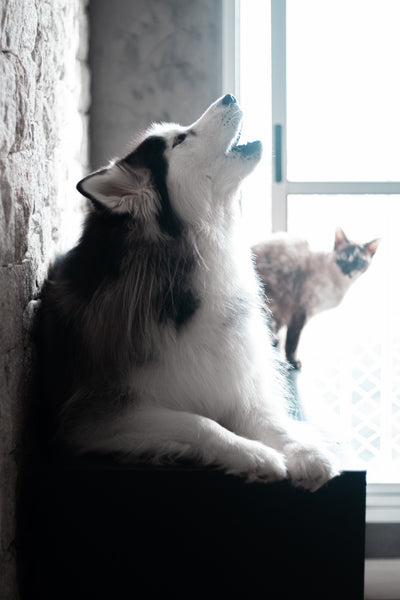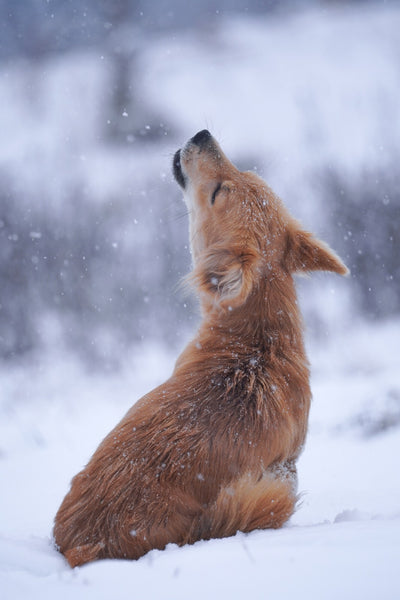The More You Know: How Do Dogs Communicate?
Have you ever wondered how to communicate with dogs or how they communicate with each other?
You’ve probably noticed that, even though they can’t talk, dogs will have arguments or agreements within the pack, just as humans do.
Dog communication seems to be mysterious in lots of ways for pet owners, but let me tell you, it’s far easier than we all think.

I remember the first night my little Lenni spent with me, right after I picked him up from the shelter.
At some point, I went to sleep and suddenly, he woke me up in the middle of the night with a really strange barking sound.
I wondered what might be wrong. I opened the door to the garden, but he didn’t need to go out.
I touched his body to see if maybe he'd hurt himself somehow, but nothing had happened.
Then I remembered: Lenni got very sick in the car that day, and as his stomach was upset, he didn’t want to eat when we first got home.
So I tried again, and BINGO.
He was very hungry and ate a bowl full of kibble.
It took me a while to understand what he was trying to say, but now I look back at it and see that it was so clear!
That’s why I decided to make this my next blog post.
I want to make it easier for you to understand what your Fluffy Friend is trying to tell you.
We’ll go over some typical dog body language, sounds and behaviours that your pooch uses to communicate.
Feeling curious?
Keep on reading!
Why Is It Crucial to Socialise Your Fluffy Friend?

As dog owners, a common misconception is that we often think we’re communicating clearly by our physical gestures and vocalising to our pets.
However, the truth is that it’s not a way of communication that our dog can actually understand.
They can only interpret in the best way they can.
Body language, vocalisation, and scent cues are all used in canine communication.
These verbal and nonverbal cues reinforce the dog's social standing within the pack.
Your dog's ancestors survived by banding together in packs to hunt, protect the young, and defend their territory from intruders.
This means that dogs are social creatures that have it in their nature to live in packs, so they require their own dog language formed by a system of common signals to communicate.
Not only does dog language allow dogs to communicate and understand one another, but it's also a conflict resolution system, with calming signals that prevent fights.
Once you understand how dogs communicate and how they interpret your verbal and nonverbal body language, you’ll be able to understand these signals and analyse your Fluffy Friend’s behaviour with other dogs more effectively.
Related: The Ultimate Guide To Travelling With Your Dog
Body Language
First and foremost, dogs use their body posture as the primary mode of animal communication.
They understand this shared language through a combination of innate knowledge and learning, similar to how humans learn how to use facial expressions.
Learning helps you understand other people better.
Understanding our Fluffy Friend’s body signals doesn’t come naturally to us, so many people interpret their dog's body language incorrectly.
This misunderstanding can lead to dangerous situations, such as mistaking an anxious dog for a completely fine one.
Here's a quick rundown of the different body language cues that dogs usually use:
A dog's head usually points in the direction of where they want to go.
A dog pointing their muzzle directly at another may indicate aggression.
Alternatively, turning their head away can indicate friendliness.
Many dogs will greet others by tilting their heads to one side to indicate they’re not a threat.

The shape of your Fluffy Friend’s mouth can be important in other ways.
A dog with a loose jaw is usually relaxed and content.
Panting, on the other hand, can be a sign of stress.
Some dogs exhibit some type of "smiling," which can be interpreted as a positive social signal.
Dogs, like humans, may yawn to help them stay awake.
When a dog yawns, it may also be an attempt to calm down an aggressive dog.
This is usually followed by the animal turning their head away.
Direct eye contact is, as often falsely believed, not a sign of hostility.
A dog may "ignore" another in order to defuse a potentially aggressive situation, so if your pooch is looking away from other dogs, it could mean they're not happy.
When a dog looks down at something, it indicates that he’s both interested and unsure.
A relaxed dog's eyes will move around with ease.
Your dog's tail position is also a vital sign.
A stiff tail indicates a perceived threat, aggression, or uneasiness.
If your pooch’s tail is sticking straight out, it is most likely an indication of aggression.
Stiffly tucked tails between the legs are typically signs of anxiety.
A wagging tail also has different meanings.
It doesn’t always indicate that the dog is content.
When dogs are insecure about a given situation, they may wag their tails as well.
Another vital sign to look for in dogs is their ears.
Erect ears are frequently associated with your pup being on high alert.
Ears that are stiff but drawn back may indicate aggression or fear.
Dogs will often flatten their ears before a fight because they don't want the other dog to bite their ears.
However, pulled-down dog ears are often a calming sign.
The shape of a dog's ears can influence how this communication works.
We strongly advise you to not alter your Fluffy Friend’s ears, as this can have serious consequences in his way of being understood by other dogs.
Dogs can communicate with their bodies in a variety of ways.
Bristled fur, for example, frequently indicates aggression. When a dog is aggressive or excited, he may stand upright.
A lowered body position has the opposite effect and often shows signs of fear in the dog.
A crouched posture, also known as the "play bow," indicates that the dog wants to play.
Related: How to Groom Your Dog at Home Like a Pro
The "Dog-Talk"

As you know, your canine companions vocalise their needs too.
The noises your pooch makes can be classified into two types: long range and short range verbal communication.
This is similar to how coyotes and wolves communicate.
Sound travels long distances, so howls, barks, yips, snarls, and growls are more easily understood.
Barks are your dog's way of conveying a variety of messages, including excitement, fear, a desire for food or water, and more.
To express surprise or distress, your dog may bark quickly.
Continuous, slow barking is frequently more aggressive — the dog is aware of the threat and doesn’t like it.
Many dogs will happily bark when they see someone they recognize.
Growling can be aggressive, but not always.
A higher-pitched growl could indicate surprise or that they’re playing.
The majority of dogs will also howl. It could indicate that the dog is bored or lonely.
In some cases, there can be sounds that naturally trigger your Fluffy Friend’s howling response, such as an ambulance siren, or another dog's howling.
Hormones and Smells
Last but probably the most important thing: the dog’s magical sense of smell.
Dogs have extremely sensitive noses and they communicate using pheromones, which their pet parents cannot detect.
Depending on which mood your dog has, he will smell differently to other dogs.
Pheromones also reveal gender and age.
When a female is in heat, her scent changes.
Pregnant dogs smell differently as well.
These pheromones are primarily produced in urine, and they assist the dog in determining how others around them are feeling.
This is also why dogs sniff each other’s behinds when they meet — it helps them learn about the other dog’s current status.
Scent signals do not require the presence of the dog to convey a message.
Urine scent can be left behind to warn other dogs of their presence.
Anal gland scents can be left when a dog defecates, which is normal, or they can be expressed when a dog is extremely nervous or fearful, leaving a lingering odour.
Related: What You Should Know Before Getting a Second Dog

So, as it turns out, pet dogs and humans communicate similarly in many ways.
Let’s summarise:
Body language is crucial and vocal signals reveal a dog's mood, however, they’re less common and less important than visual signals, as they don't convey a wide range of emotions and aren't used nearly as frequently.
Body language is always used by dogs, while vocal signals are only used when necessary.
Pheromones are constantly produced by dogs.
These scents aren’t detectable by humans.
Dogs, on the other hand, use them to communicate a wide range of information.
While some of the communication comes naturally to dogs, practice does make perfect.
Unsocialised dogs may have difficulty communicating, which makes them more aggressive and fearful as they actually have no idea what the other dog is saying.

We recommend you to pay attention to both the auditory and visual cues that your Fluffy Friend exhibits and learn the different ways of how they communicate.
This will definitely improve your dynamic and strengthen your relationship with your pooch!
How does your pooch communicate with a strange dog or human?
I encourage you to write in the comments down below and tell us all about the signs and language that your Fluffy Friend uses.
Every doggie is different!
By sharing our experiences, we become better dog owners.
Until next time, stay Fluffy,
Your MrFluffyFriend Team
Looking for some products that could help you out with your training?
Check out our Online-Shop!
Here some useful products in relation to the blog:

8 comments
Our dog Yussi is female and she has several male dog friends in our close neighborhood. They sniff and then they play, running around, chasing each other until they tired out. She is less enthusiastic about female dogs.
I have 2 Shih Tzu dogs. They are one year old – male and from the same litter. They have started barking a lot recently and I am finding it is very hard to stop them.. as I live in an apartment it is starting to prove difficult. They bark when I go out and can keep it up for quite a while. They bark when I put them to bed. – they want to come into my bed. One little guy Georgie barks when playing and chasing around and when I give him a stern. ‘Stop’. He looks, stops and then practically smiles and looking straight at me, gives a loud ‘woof woof’. – I won’t. Then he gets Dusty barking too.
They have a good size garden to run in and chase around the bushes. I am on the ground floor so they hop out the patio door and run in and out. We are very lucky to have it. Any advice? I have always had 2 dogs, usually from the same litter and have never had this problem before.
It would kill me to have to separate them, by giving one away. – They would be devastated if I separated them and I would be too.
My husband was always on hand and dogs I find are much better for men, He died some years ago so I have had to work with them myself. But I have always had dogs so it’s nothing new. – but for some reason this little divil will not stop barking..
Any ideas?
Ann
Thanks for the always interesting info in your blog. FYI my little dog loves her bed, blanket and the chew toy. Thanks for the great products.